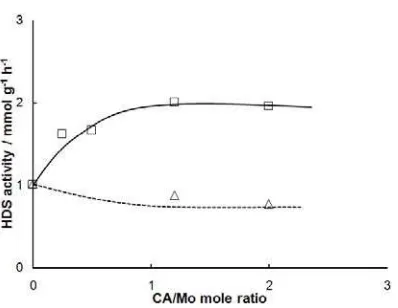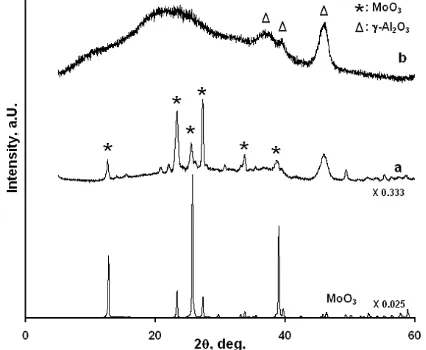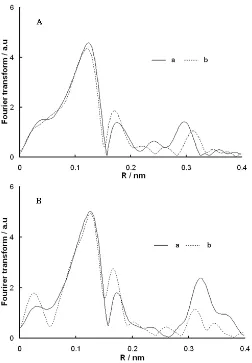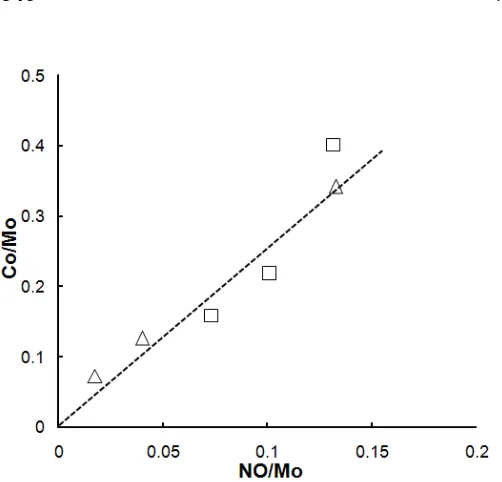PREPARATION OF HIGHLY ACTIVE Co-Mo/Al
2O
3HDS CATALYSTS WITH CITRIC ACID
ADDITION BY THE POST-TREATMENT METHOD
Nino Rinaldi
Research Center for Chemistry, Indonesian Institute of Sciences, Kawasan PUSPIPTEK, Serpong 15314, Tangerang
Received September 30, 2010; Accepted October 28, 2010
ABSTRACT
A study of the influence of citric acid (CA) addition by a post-treatment method during the preparation of a
series of Mo/Al2O3 catalysts on the thiophene HDS activity was conducted. The Mo/Al2O3 catalysts were also
prepared by a chemical vapor deposition (CVD) technique using Co(CO)3NO to introduce Co atom and
characterized by means of NO adsorption, XRD, Mo K-edge EXAFS and XRF. With 8.7 wt% Mo, citric acid was not
affected very much for the Co-Mo/Al2O3 catalysts. On the other hand, an outstanding result was shown that the HDS
activity was drastically enhanced by 5 times up to Mo content around of 25 wt% Mo. It is suggested that the post
treatment increased the dispersion of MoS2 particles, in particular at a high Mo loading. This was also supported by
the amount of NO adsorption and amount of Co anchored by the CVD results, which enhanced as the increasing Mo loading up to 25 wt% Mo. Moreover, Mo–CA complex species were observed on the post-treatment method and CVD technique was one of advanced method to prepare Co-Mo-S phases selectively.
Keywords: preparation, citric acid, post-treatment, hydrodesulfurization, CVD
INTRODUCTION
Development of highly active hydrodesulfurization (HDS) catalysts is still needed not only for obtaining zero sulfur emission and zero sulfur fuel in the future, but also to efficiently utilize limited natural resources. Supported nickel- or cobalt-molybdenum sulfide catalysts are widely used in the industrial HDS process [1]. It is now well recognized that the active sites of the HDS catalysts are the so-called Co(Ni)-Mo-S phase, in which Co(Ni)
decorates the edge sites of highly dispersed MoS2
particles [1]. Therefore, many improvements of HDS catalysts preparation have been proposed in order to get a greater amount of active sites, Co-Mo-S phases, as well as better knowledge of the structure of catalytically active phase, support-active phase interaction and new activation procedure. One simple and effective method to boost catalytic activity is with the use of chelating agent in the catalysts preparation [2], for instance citric acid (CA).
In the catalyst preparations, chelating agents are usually added by the simultaneous impregnation method, including citric acid. It has been reportedly that with using citric acid with the simultaneous-impregnation method, better performance of the HDS catalytic activity
is obtained [2]. Moreover, the dispersion of MoS2
particles and the degree of sulfidation of Mo oxide precursors are also improving [2-3]. Similar result is also observed on our previous result when citric acid was
added by the simultaneous impregnation method in the catalyst preparation [4]. However, information about the detail roles of citric acid is still unclear. In the present study, other preparation method of addition of citric acid was conducted. Citric acid was impregnated on
the calcined Co-Mo/Al2O3 catalysts, as called a
post-treatment method here. We studied the influence of citric acid to the performance on the HDS reaction of thiophene related with a series content of Mo and CA, and characterized them by a variety of physicochemical techniques. A chemical vapor deposition (CVD)
technique with Co(CO)3NO as the probe molecule was
used to introduce Co atom on the sulfide Mo/Al2O3. By
CVD, all of the Co atoms were preferentially anchored
on vacant MoS2 edge sites, resulting in the full
occupation of the edges of the MoS2 particles with Co
atoms [5-7]. Hence, the maximum potential activity of Co-Mo catalysts can be estimated [6-7].
EXPERIMENTAL SECTION
Materials
The commercial standard of γ-Al2O3 (JRC-ALO-7)
was supplied by the catalysis society of Japan.
Ammonium heptamolybdate (NH4)6Mo7O24·4H2O, citric
acid (C6H8O7), thiophene (C4H4S) and cobalt carbonyl
(Co(CO)3NO) were used in here as analytical grade.
* Corresponding author. Tel/Fax : +62-21-7560090 Email address : [email protected]
Nino Rinaldi
Moreover, all gases (He, H2, 10% NO/He and 10%
H2S/H2) were used as a high purity quality.
Instrumentation
On-line gas chromatography (GC), X-ray fluorescence (XRF), X-ray diffraction (XRD), and Mo K-edge X-ray Absorption Fine Structure (XAFS) were apparatus that used in the present study.
Procedure
aqueous solution, followed by calcination at 773 K for 5 h. The Mo content of Mo/Al was 8.7-35 wt% Mo. Then, the calcined Mo/Al was impregnated with a citric acid (CA) aqueous solution (CA/Mo mole ratio = 2); this step was followed by just drying at 383 K for 16 h (without calcination). This catalyst preparation technique is denoted here as a post-treatment method. Another series, the CA/Mo mole ratio was varied up to 2 with 8.7
and 20 wt% Mo/Al2O3 catalysts were also prepared by
the post-treatment method. The pH of the impregnation solution was not adjusted in the present study.
The prepared catalysts were sulfided in a 10%
H2S/H2 flow at 673 K for 1.5 h. The sulfidation
procedures have been described previously [4]. A chemical vapor deposition (CVD) technique using
Co(CO)3NO as a precursor was applied to introduce Co
into the sulfided Mo/Al2O3 catalyst [4-7]. Briefly, the
sulfided catalyst was first evacuated at 673 K for 1 h and subsequently exposed for 5 min at room temperature to
a vapor of Co(CO)3NO kept at 273 K. After 10 min
evacuation at room temperature, the sample was sulfided again at 673 K for 1.5 h. The catalyst thus
prepared is denoted as Co-Mo/Al2O3. The amount of Co
incorporated by the CVD technique was determined for the sulfided catalysts by means of XRF analysis (Shimadzu, EDX-700HS). The accuracy of the Co content was within ± 5%.
Reaction Procedure
The initial activity of the freshly prepared catalyst was evaluated on the HDS reaction under mild conditions using a circulation system made of glass (batch system). The catalyst (about 0.1 g) sulfided in-situ was evacuated at 673 K for 1 h before the catalytic reaction. The HDS of thiophene was carried out at 623 K
and the initial H2 pressure of 20 kPa. The thiophene
pressure was kept constant (2.6 kPa) during the reaction [4-5]. The reaction products were analyzed by on-line
gas chromatography. The products were mainly C4
compounds such as n-butane, 1-butene, and cis-/trans
-2-butene and a corresponding amount of H2S. The
output products were periodically monitored during the reaction. The HDS activity was calculated on the basis
of the accumulated amount of H2S evolved after 1 h
reaction divided by the catalyst weight. The amounts of
H2S evolved from the sulfided catalysts were estimated
by blank experiments without introduction of thiophene vapor into the reactor, showing that they were
negligibly small [less than (5-10) × 10-5 mol h-1 g-1]
compared with the amount of H2S formed by the HDS
reaction. The reproducibility of the HDS activity test
was better than ± 4%.
Characterizations
The amount of NO adsorption on the sulfide
Mo/Al2O3 catalyst prepared by citric acid addition was
measured by a pulse technique. After cooling in the
H2S/H2 stream, the sulfided catalyst (0.1 g) was flushed
at room temperature with a high purity He stream
(20 cm3 min−1). A pulse of 5.0 cm3 of 10% NO/He
(purity of NO > 99%, atmospheric pressure) was repeatedly injected every 8 min to the He stream by using a six-way stopcock until no adsorption was
detected (pulse size; 20 μmol NO/pulse, 10–15 pulses).
The effluent gas was analyzed by a gas chromatograph equipped with a thermal conductivity detector to measure the amount of NO. The amount of NO adsorption was calculated from the cumulative amount of NO adsorption. The reproducibility was usually within ± 5% of the total amount of NO adsorption [5,8].
Moreover, X-ray diffraction (XRD) measurements were carried out on a Miniflex II Desktop X-ray Diffraction apparatus (Rigaku) with 30 kV and 15 mA, equipped with an automatic divergence slit. The
radiation source was Cu Kα1,2 (λ = 1.541841 Å) with a
Ni filter. Mo K-edge X-ray Absorption Fine Structure
(XAFS) spectra were measured for oxidic Mo/Al2O3
with or without the citric acid addition and for reference compounds in a transmission mode at room temperature at NW-10A in the PF-AR (Photon Factory-Advanced Ring for pulse X-Rays) of the Institute of Material Structure Science, High Energy Accelerator Research Organization (KEK-IMSS-PF-AR) with 6.5 GeV ring energy and 100-50 mA stored current (proposal No. 2006G331, 2008G200). The synchrotron radiation was monochromatized by a Si (311) double crystal monochromator. The EXAFS data were analyzed by assuming a spherical wave approximation and a single scattering model. The EXAFS data were
Fourier-transformed from k-space (40-150 nm-1) to R
-space. The empirical backscattering amplitude and phase shift for Mo-Mo pairs were extracted from
Nino Rinaldi
Fig 1. HDS activity of Mo/Al2O3 catalysts as a function of
CA/Mo mole ratio by the post-treatment method. (Δ) 8.7
wt% Mo and (□) 20 wt% Mo
Fig. 1 shows the catalytic activity of the Mo/Al2O3
catalysts for the HDS of thiophene as a function of CA/Mo mole ratio. The HDS activity of the 8.7 wt%
Mo/Al2O3 catalysts was slightly decreased by the
addition of citric acid using post-treatment method up to CA/Mo mole ratio = 1 and was leveled off by a further
addition of citric acid. With the 20 wt% Mo/Al2O3
catalysts, the HDS activity was significantly increased when citric acid was added by the post-treatment method up to a CA/Mo mole ratio around 1 and became constant at CA/Mo > 1. It is noteworthy in Fig. 1 that the effect of citric acid addition strongly depends on the Mo
loading and that the HDS activity of 20 wt% Mo/Al2O3 is
significantly increased by the post-treatment with citric acid at CA/Mo mole ratio > 1.
Fig. 2 depicts the HDS activity of a series of
Mo/Al2O3 catalyst as a function of Mo loading with/out
the citric acid addition. The HDS activity of calcined
Mo/Al2O3 catalysts was gradually decrease as the Mo
loading was increased, suggesting that the dispersion
area of MoS2 particles was not enough on the Al2O3
surface (3-3.2 Mo nm-2) and the bulky MoO3 crystalline
became created, in agreement with our previous result
[6]. However, on the post-treated Mo/Al2O3 catalysts,
the HDS activity was enhance 2 times even at higher
Mo loading (Mo ≤ 25 wt%). It seems that the dispersion
of MoS2 particles was enhanced with the addition of
citric acid. It is suggested that together with citric acid,
perhaps, MoO3 crystalline rendered the Mo-CA
complex structures and become well dispersed on the support.
Moreover, the CVD technique was applied to get deeper insight into the different behaviors of these
catalysts in Fig. 2[7]. The HDS activity of calcined
Co-Mo/Al2O3 catalysts was sharply decrease with
increasing Mo loading, explaining that the dispersion of
MoS2 particles become decreased as a high Mo
loading. Surprisingly, Fig.2 shows that the HDS activity was drastically increase even at higher Mo loading (up to 25 wt% Mo) which almost reach 5 times compare with the calcined catalysts before the CVD. It means that a great amount of active sites, Co-Mo-S phases, was formed because of the formation of highly
dispersed of MoS2 particles on the support when citric
acid was added by the post-treatment. It is noteworthy that a post-treatment method with citric acid is effective to improve the performance activity of HDS catalyst.
Dispersion of Mo prepared by citric acid
The amount of Co anchored by the CVD process was evaluated by XRF analysis. The amounts of Co in
Co-Mo/Al2O3 with/out the citric acid addition are
depicted in Fig.3 as a function of Mo content. Obviously, the amount of Co on the calcined
Co-Mo/Al2O3 was decreased as the Mo content was
increased, indicating that the edge dispersion of MoS2
particles become decreased with the increasing of Mo content. On the other hand, the amount of Co on the
post-treated Co-Mo/Al2O3 catalysts significantly
increased up to Mo content around of 25 wt% Mo. It
seems that the MoS2 particles are still highly dispersed
on the support Al2O3 even at a high Mo loading by the
post-treatment with citric acid.
Similar trend result is also observed on the NO adsorption capacity shown in Fig. 4. With the post-treatment, the NO adsorption capacity is still increased
Nino Rinaldi
observed on the calcined Mo/Al2O3 catalysts. The
amounts of NO adsorption (Fig. 4) and Co incorporation (Fig. 3) clearly show that the post-treatment of the calcined Mo/Al catalysts with citric acid
greatly increases the dispersion of MoS2 particles and,
correspondingly, the amount of active sites, Co-Mo-S. Moreover, interesting point is shown at the 8.7 wt% Mo content in Fig. 4. The amount of NO adsorption was not changed after the citric acid was added. It considers that Mo has already well dispersed forming monolayer on the surface support [6], in consistent with the result in Fig. 2.
Fig. 5 shows that MoO3 diffraction peaks were
clearly observed for the calcined 20 wt% Mo/Al catalyst
together with the peaks due to γ-Al2O3. The diffraction
peaks due to crystalline MoO3 were removed when
citric acid was used by the post-treatment (Fig. 5-b) and become boarded peaks. It is considered that citric
acid consumes the crystalline MoO3 particles to form
Mo-CA complexes and Mo becomes well-dispersed or
in an amorphous form on the surface Al2O3.
Meanwhile, the XRD patterns of the calcined Mo/Al
catalyst with 8.7 wt% Mo showed no MoO3 diffraction
peaks with or without the addition of citric acid by the post-treatment, indicating that Mo is already well-dispersed on the support forming monolayer at 8.7 wt% Mo [6].
Fig 3. The amount of Co anchored by the CVD for
Co-Mo/Al2O3 (CA/Mo mole ratio = 2) as a function of Mo
loading. (Δ) calcined and (□) post-treatment
Mo K-edge XAFS measurements were conducted in order to get information on the local structure of Mo species. Fig. 6 shows the Mo K-edge XAFS Fourier
transforms (FT) for oxidic Mo/Al2O3 prepared by the
post-treatment method using citric acid (CA/Mo = 1.2). This present study only used the Mo-Mo region to discriminate these Mo species due to the Mo-O region 0.08–0.20 nm is not well resolved for differentiation of Mo species. And thus, only the Mo-Mo region 0.23– 0.40 nm was analyzed to characterize Mo species in
the Mo/Al2O3 catalysts. The Mo-Mo structural
parameters, as derived from the XAFS analyses for the oxide catalysts, are listed in Table 1. As shown in Table
1, the Mo-Mo atomic distance for the 8.7 wt% Mo/Al2O3
catalysts was 0.33 nm after calcination, indicating that molybdenum is present mainly as polymolybdate-like species (Fig. 6A). The Mo-Mo atomic distance was increased to 0.34 nm and became close to that for the Mo-CA complex, when citric acid was added by the post-treatment method, showing that Mo-CA complexes are formed even at a CA/Mo mole ratio of 1.2, in consistent with Fig.1. However, the Mo-Mo coordination number of the catalysts was lower than that for the reference compound as listed in Table 1, suggesting a structural disorder of Mo-CA complexes due to the interaction with the support surface and/or a partial formation of the complexes. Nevertheless, the
Fig 4. The amount of NO adsorption capacity of
Mo/Al2O3 prepared by CA addition as a function of Mo
loading (CA/Mo mole ratio = 2.0). The symbols are the same as those in Fig.3.
Fig 5. XRD patterns of the 20 wt% Mo/Al2O3 catalysts
prepared by the addition of citric acid (CA/Mo = 2). (a) calcined and (b) post-treatment. The XRD pattern of
Table 1. Structural parametersa derived from Mo K-edge EXAFS for Mo/Al oxide catalysts prepared by using citric
Fig 6. Fourier transforms of k3-weighted Mo K-edge
EXAFS for Mo/Al2O3 prepared by CA addition (CA/Mo
mole ratio = 1.2). (A) 8.7 wt% Mo and (B) 20 wt% Mo: (a) calcined and (b) post-treatment
presence of a Mo-CA monomeric complex is not excluded for these catalysts.
With the 20 wt% Mo/Al2O3 catalysts shown in Fig.
6B, the Mo-Mo atomic distance for the calcined catalyst was 0.37 nm. It is clearly shown that molybdenum is
present predominantly as MoO3 species on the
calcined catalyst, in conformity with the XRD results shown in Fig. 5. When citric acid was used in the preparation, the Mo-Mo atomic distance became 0.34 nm by the post-treatment. The local structure of Mo in
20 wt% Mo/Al2O3-post-treated shows the formation of
Mo-CA surface complexes. However, the Mo-Mo coordination number of the Mo-CA surface complexes (0.3) was considerably lower than that of the reference compound (Table 1), suggesting that the Mo-CA
complexes on 20 wt% Mo/Al2O3 catalysts are in
structural disorder and/or are partially formed. We conclude from the characterizations by XRD and XAFS
that citric acid consumes crystalline MoO3 particles
and, probably, coexisting well-dispersed Mo oxide clusters to form highly dispersed Mo-CA surface complexes and, in part, polymolybdate species by the post-treatment of calcined Mo/Al with citric acid. The Mo K-edge XANES spectra for these catalysts (not shown for brevity) are consistent with this conclusion.
Effect of post-treatment on Mo/Al2O3 catalyst
Fig. 2 clearly shows that the HDS activity of 8.7
wt% Mo/Al2O3 and Co-Mo/Al2O3 is not changed or even
decreased with the addition of citric acid by the post-treatment method. The amounts of NO adsorption (Fig.
3) demonstrate that the dispersion of MoS2 particles is
unchanged or even decreased after citric acid was added. Therefore, we conclude that with the 8.7 wt%
Mo/Al2O3 catalyst system the addition of citric acid does
Nino Rinaldi
Fig 7. Correlation between the NO/Mo mole ratio for
Mo/Al2O3 and the Co/Mo mole ratio for Co-Mo/Al2O3 by
the CVD. (Δ) calcined and (□) post-treatment
not affect the catalyst properties very much or is even
detrimental, since in the present Mo/Al2O3-calcined
catalyst a monolayer dispersion of Mo is established and Mo oxides are extremely highly dispersed on the support at 8.7 wt% Mo [1,6,9]. Yet, Mo K-edge XAFS (Fig. 6A) clearly show that Mo-CA complexes are formed by the addition of citric acid. We consider that the Mo-CA complex formation weakens the support-Mo precursor interactions and thus results in a slight decrease of the
dispersion of MoS2 particles.
Moreover, the present study demonstrates that the
HDS activities of 20 wt% Mo/Al2O3 and Co-Mo/Al2O3 are
significantly increased after citric acid was added by the post-treatment method (Fig. 2). Figs. 3 and 4 clearly
show that the dispersion of MoS2 particles is greatly
increased by the post-treatment at a high Mo content (up to 25 wt% Mo). It is revealed by XRD (Fig. 5) and the Mo K-edge XAFS (Fig. 6 and Table 1) that, in the case of
the post-treatment, citric acid consumes crystalline MoO3
particles and, probably, coexisting well-dispersed Mo oxide clusters to form well-dispersed Mo-CA surface complexes. The present study demonstrates that the addition of citric acid by the post-treatment is very
effective to increase the edge dispersion of MoS2
particles on the catalysts, in particular, at a high Mo content (up to 25 wt% Mo).
We also propose that other favorable effects of
citric acid addition on the 20 wt% Co-Mo/Al2O3 catalysts
causes weakened interactions between Mo and the support surface due to the formation of Mo-CA surface complexes as well as the increased dispersion of Mo
precursors at the expense of crystalline MoO3 particles.
Therefore, facilitating easy sulfidation of Mo and thus
improving the sulfidation degree of Mo on the Mo/Al2O3
catalysts by the post-treatment method, in particular at high Mo loading (20 wt% Mo). This agrees with the observations by Funamoto and Segawa [3] and by Fujikawa et al. [10].
Moreover, in order to estimate the adsorption
sites of Co(CO)3NO on MoS2, we made a correlation
between the Co/Mo mole ratio for Co-Mo/Al2O3 by the
CVD and the NO/Mo mole ratio for Mo/Al2O3 as
depicted in Fig. 7. It is shown that a good proportional correlation in Fig. 7 for these catalysts, demonstrating
that the Co atoms introduced to Mo/Al2O3 by the CVD
was selectively decorated on the edge sites of MoS2
particles to form active sites, Co-Mo-S phases, since it is well established [1] that NO molecules absorb on coordinatively unsaturated Mo sites on the edge sites
of MoS2 particles [5]. However, it is also shown in Fig. 7
that the Co/Mo ratio for the post-treatment catalysts at 8.7 wt% Mo was slightly higher than the value expected from the linier line, describing an excess amount of Co
over that requires for full decoration on MoS2 edges
sites is anchored on 8.7 wt% Mo/Al2O3-post-treatment.
It is suggested that Co atom was also adsorbed on the
Al2O3. With 8.7 wt% Mo, a monolayer dispersion of
MoS2 particles (3-3.2 Mo nm
-2
) was already formed on the support. Therefore, the addition of citric acid just modified the interaction between support and Mo
precursor and the textural properties of Al2O3. Thus,
some of Co atoms is also anchored with the surface
Al2O3 together with citric acid. Moreover, it is worth to
be noted that the CVD technique is one of advanced method for the HDS catalyst preparation to prepare active sites selectively, Co-Mo-S, without the formation
of Co sulfide clusters, Co9S8 [5-7].
CONCLUSION
Based on the HDS activity and the physicochemical data, it is concluded that the HDS
activity and the edge dispersion of MoS2 particles are
not modified very much by the post-treatment method with citric acid at 8.7 wt% Mo loading due to already monolayer dispersion. On the other hand, significantly improvement of the HDS activity and the edge
dispersion of MoS2 particles are observed at a high Mo
content (up to 25 wt% Mo) by the post-treatment. It is
indicated that citric acid consumes crystalline MoO3
particles on the calcined MoO3/Al2O3 by the
post-treatment method to form well-dispersed Mo-CA surface complexes and thus improves the edge
dispersion of MoS2 particles on the catalyst surface
after sulfidation. Moreover, it is suggested that the
sulfidation degree of Mo for Mo/Al2O3catalysts is also
Nino Rinaldi
one of advance method for the HDS catalysts preparation to form Co-Mo-S phases selectively without the formation of Co sulfide clusters.
ACKNOWLEDGEMENT
I express my thanks to Prof. Y. Okamoto for his discussion, advices, and support during this work, also Dr. T. Kubota for the Mo K-edges XFAS measurements of the catalysts.
REFERENCES
1. Topsøe, H., Clausen, B.S., and Massoth, F.E., 1996,
Catalysis: Science and Technology, Springer, Berlin,
Vol. 11.
2. Sun, M., Nicosia, D., and Prins, R., 2003, Catal.
Today, 86, 173–189.
3. Funamoto, T., and Segawa, K., 2007, 11th
Korea-Japan Symp. Catal., Preprint, GO-37.
4. Rinaldi, N., Usman, Al-Dalama, K., Kubota T., and
Okamoto, Y., 2009, Appl. Catal., A, 360, 130–136.
5. Okamoto, Y., Ochiai, K., Kawano, M., Kobayashi,
K., and Kubota, T., 2002, Appl. Catal., A, 226, 115–
127.
6. Okamoto, Y., Ishihara, S., Kawano, M., Satoh, M.,
and Kubota, T., 2003, J. Catal., 217, 12–22.
7. Okamoto, Y., Ochiai, K., Kawano, M., and Kubota,
T., 2004, J. Catal., 222, 143–151.
8. Okamoto, Y., Kawano, M., Kawabata, T., Kubota,
T., and Hiromitsu, I., 2005, J. Phys. Chem. B, 109,
288–296.
9. Eijsbouts, S., 1997, Appl. Catal., A, 158, 53–92.
10. Fujikawa, T., Kato, M., Ebihara, T., Hagiwara, K.,
Kubota, T., and Okamoto, Y., 2005, J. Jpn. Pet.



